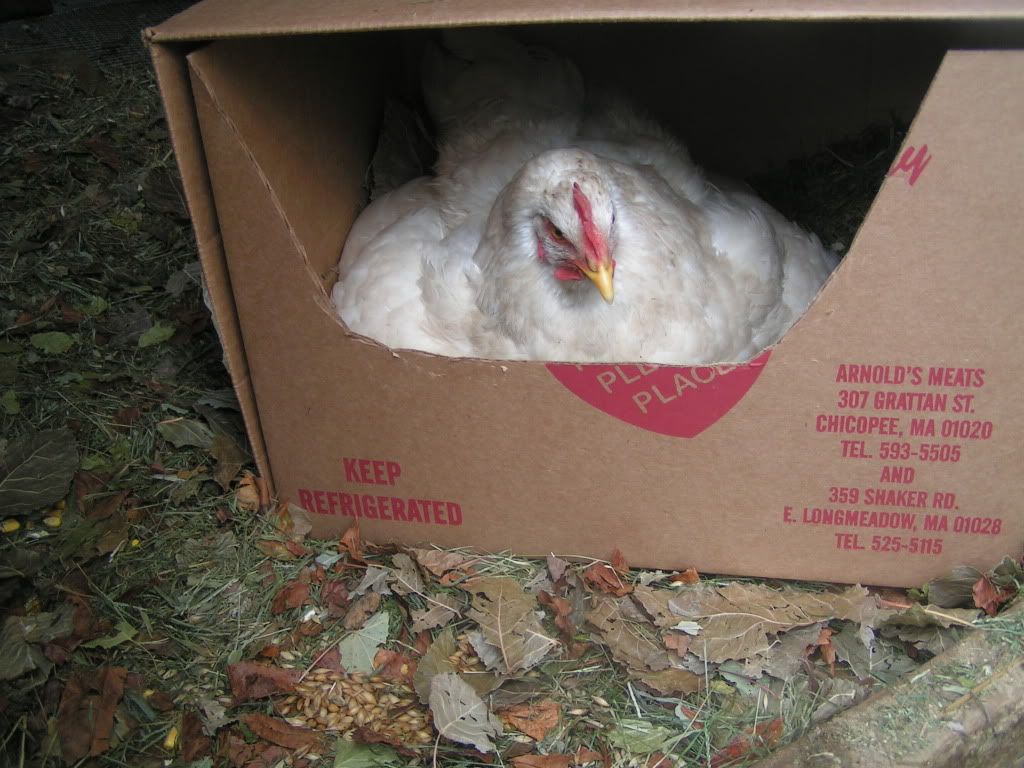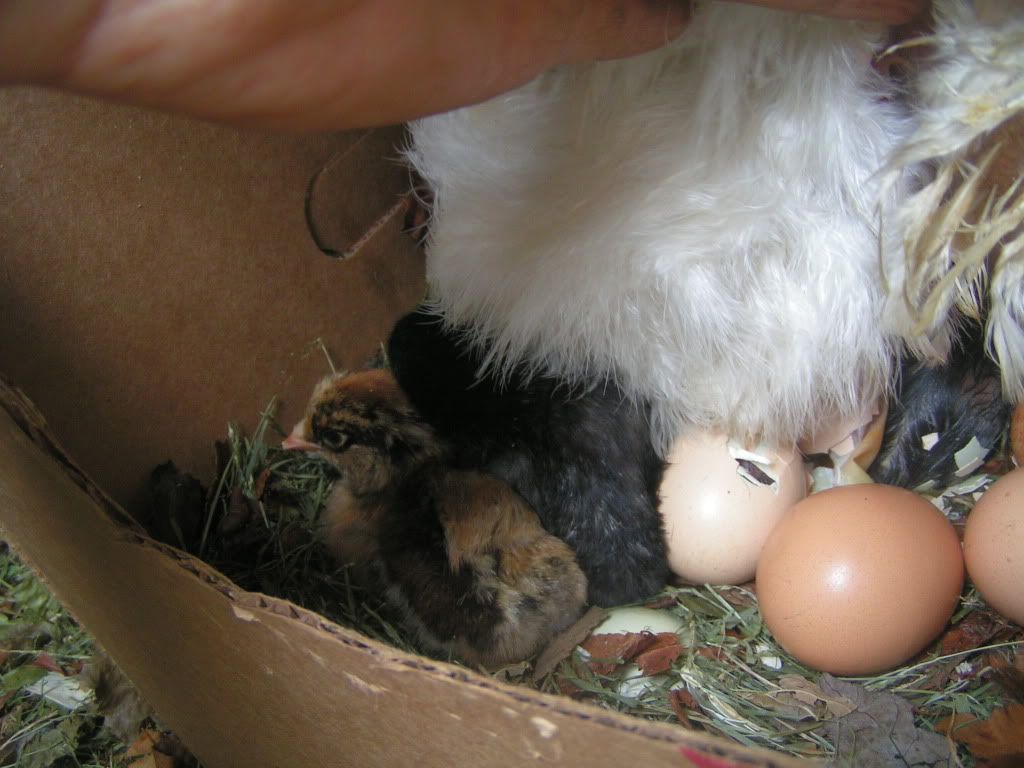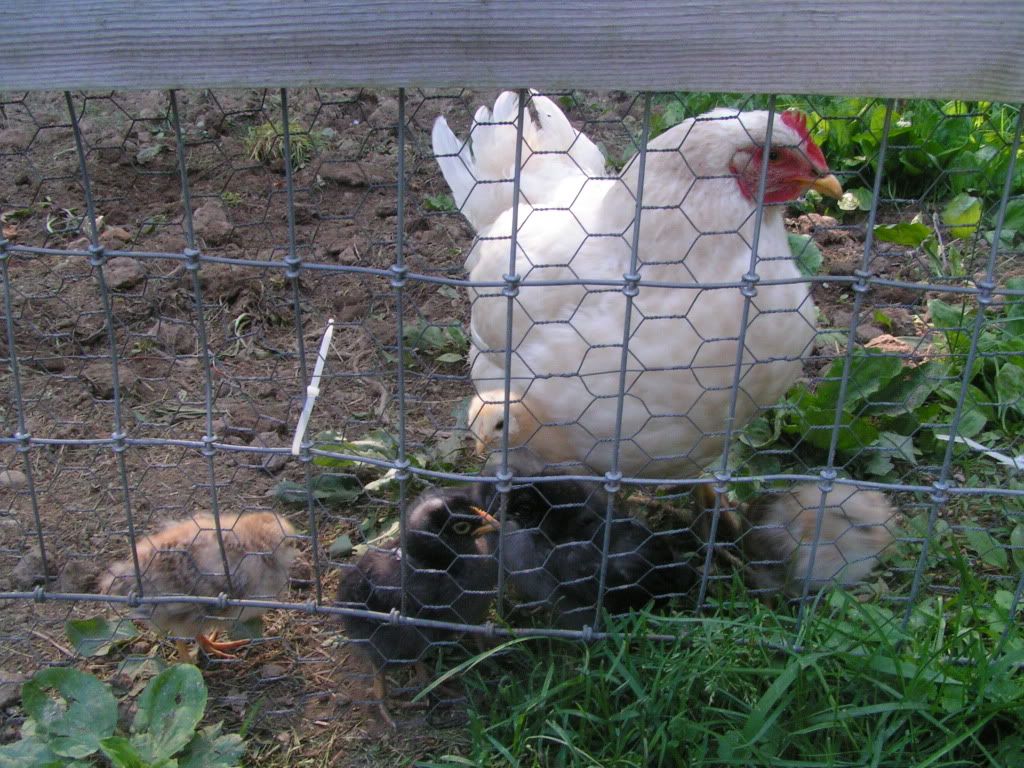Ya know how all those advertisements and labels say "no hormones?" Our eggs have no hormones, our chickens are growth-hormone free, our milk is hormone free, etc? Well, lean in a bit closer, I have some bad news for ya.
Soy. Yup, soy. They don't have to label it as a hormone, but when it is fed to the animals, it behaves in the body like hormones.....particularly estrogen. It makes chickens lay more eggs and start at a younger age. It makes cows give more milk. It makes human girl babies develop sexually at a frighteningly young age....as young as 6 years old!.....and stunts the sexual development of little boys. Men, do you like boobs? Well, good, because you'll have a pair on your own chest if you continue to eat soy.....and soy is in almost every processed food today.
And it is used to grow the meat, eggs, and dairy products found in grocery stores all over this country.
Not on my farmlet. We are soy-free here and plan on staying that way.
That can be a challenge when raising young chicks without a hen for a mother to show them how to find worms and bugs. Commercial chick starter feeds depend heavily on soy for the protein. Have you seen those egg cartons in the grocery store labeled "our hens eat a vegetarian diet?" Lean in a little closer, my dear, and hear this: Chickens are not vegetarians! They are omnivorous, and depend rather heavily on the protein portion of their diet.
When I had broody hens raising their own chicks, they knew what to feed them. Even though these hens were not raised by a hen themselves, but under a heat lamp in my cellar, they knew what was real food for their little ones. Worms. Lots and lots of worms. I would watch them feed their babies by scratching in the dirt and placing a small worm on the ground in front of a chick. If the chick was very young and didn't immediately snatch up the worm, the mama hen would pick it up and put it down again in front of the chick. The little ones instinctively go for movement, and would quickly see the movement of the worm or grub and swallow it down.
I fed her grains, and even ground some up so she could offer it to the chicks. They wouldn't eat it. They just wanted fresh, live worms.
Vegetarian chickens? Seriously?
(Sadly, the above hen was killed by a young bald eagle last spring, hence my quest for a small flock of broody hens....and my Icelandic project. She successfully raised the chicks in the photos, and the girls are all laying eggs for us this year. The boys.....*burp*.....well, let's just say we enjoyed the roosters and leave it at that, shall we?)
Online research (most of it) would have you believe that we commoners are far too stupid to figure out how to keep our birds healthy so we need to rely on the big feed manufacturers to help us. Hogwash. All you need is a basic understanding of simple math and a few readily available ingredients. I'll give you my recipe, but also the principles to guide you so you can always formulate feed with whatever ingredients are available when you have chicks to feed.
I used whole wheat that I got for free from a clean-out last year. I have some whole wheat that I sprout for the goats and hens, and got several cases of these cans of cracked wheat that I set aside for raising chicks. This is readily available through co-ops and online, but you can use other options....get ideas from the site linked above, the one with the math lesson. I use what I have, and you should, too.
I feed Taste of the Wild dry catfood, venison version, to my barn cats. This is a soy-free food with a very high protein content, higher than soy. This was an easy source of protein for my mix. I also added a small amount of alfalfa pellets for an easy source of greens, until they reliably eat grass and weeds and such.
Using Pearson's Square and my ingredients, I came up with a recipe. 7.5 parts catfood, 2 parts alfalfa, and 26 parts wheat. Change "parts" to "ounces" and you have my current recipe.
After grinding the catfood and alfalfa pellets in my Vitamix, I layered it with the wheat in gallon jars, mixed it with my hands, and voila! Chick starter, free of phyto-estrogens....soy.
I went a little heavy on the protein, upping the catfood to 8 oz from 7.5. Err on the side of caution, I figured.
Commercial chick starter is so finely ground that the little ones don't need to "chew" it. Chickens....all birds, really....grind their food in their gizzards, a very muscular, hollow organ that they swallow pebbles into. The gizzard squeezes the food against the pebbles, acting like a mouth full of teeth thoroughly grinding the food. Since my mix is not so finely ground, I also feed granite bits called "grit" to my chicks. Beware of oyster shell sold as grit....it will dissolve in the bird's gizzards and not be useful for grinding, and will supply too much calcium to young chicks. I've been known to pick up fine bits of sharp rocky sand and rinse it off (from a dirt road) when I couldn't locate crushed granite.
I load their feeder with my mix and sprinkle a bit of grit on top. Later, they will get their food selections in separate containers so they can begin to learn to balance their own diets, as my adult flock is expected to do. I have already started this process by adding some whole grains and some clumps of grass with roots and dirt to their home.
For the sake of safe water (chickens will poop in their water source....a LOT!) I add a glug of raw organic apple cider vinegar to their waterer when I fill it up. This has a mild disinfecting effect and also provides good bacteria to aid in digestion. The dirt from the grass clumps, taken from my organic garden, also provide wonderful good bacteria to populate the digestive tract of the growing birds.
Aren't they getting big? Look at those wing feathers...and most of them have little tail feathers now. Still cute, but at almost three weeks old, they are starting to resemble small chickens. As soon as they are feathered out, they can live outside without the heat lamp. I can't wait for that day! Neither can they. They are off to a great start.










This is the most sensible chick post I've read. Thanks, even though I don't raise birds (yet, anyway).
ReplyDeleteThanks! To be continued....
ReplyDeleteAlmost 2.5 weeks old, they grow so fast!! Am I correct in assuming the smaller ones are the Icelandics? Will they be a smaller bird when full grown? I am wondering what you do for the micro-nutrients?
ReplyDeleteI am glad you made the point about oyster shell not being good for grit. Too much calcium, even in laying hens, can cause kidney failure. Reference: http://poultryworld.tripod.com/dis_dir.htm see VISCERAL GOUT bottom right.
I must add a word of warning about using grit from roads. I saw you said you washed it. We did too. Lost a few chicks anyways. Now I collect grit from rivers and dry it over the summer and then store it. But make SURE it's dry. It will freeze solid otherwise.
As I must feed grit year round, I fill a 55 gallon trash can each year. That's enough for 50 broilers for 3.5 months and 18 layers year round. Those of you with some rocks in your soil, don't curse them too much!
Not to worry, Pam, the grit I foraged came from a barely used dirt farm road, not the public road.
ReplyDeleteMy birds are not confined, so I can be a lot looser with their food than I would if I had to confine them. The adults roam over several acres....ours and the neighbors'. I only need to supply grit to my adult birds if there is solid snow cover, so I don't use very much. I think I'm still on the same bag I bought 3-4 years ago.
Those chicks will be three weeks old tomorrow! The smaller ones are the Icelandics, although some of them are almost the same size as the larger chicks. There is a huge variation in the Icelandics, at least so far. The are supposed to mature to a size somewhere in between standard layers and bantams.
Great article! I need to ttry this. Where do you find taste of the wild cat food?
ReplyDeleteGreat work! Look at those chicks - they are doing great!
ReplyDeleteI got it at Tractor Supply Company, but it is also available at the larger pet stores.
ReplyDeleteI realize that I didn't address Pam's micro-nutrient question. I don't worry too much when they are itty-bitty, as they have retained yolk to keep them going for the first three days. Then there are micro-nutrients in the catfood, and by the end of their first week they are pretty vigorous about scratching in the roots of the grass clumps that I provide for them. You might see one in my picture of the chicks above....that clump has only been in with the chicks for a few hours. It will be completely shredded within a day. It took them a few days at first. I'm sure they get a LOT of their needs from that taste of the outdoors.
OFG, you remember the hatchery batch I got last fall that did so poorly....now my confidence is back that it was not my management practices! I think I just got a bum batch last year.
ReplyDeleteWhat about food for laying hens? I would love to avoid GMO ingredients like corn and soy but organic feed is expensive and shipping charges are often higher than the product itself. We feed our dog Taste of the Wild, although they had a recall recently due to salmonella. Never thought of giving it to the chickens.
ReplyDeleteI'll do an article on what I feed my hens....variety is the key! Coming soon....but yes, it is very hard to find ingredients, and sometimes we are not able to get what we want in organic choices. My motto: Do your best and move on. Try not to obsess. Try. Really try. OK, I'm obsessing about not obsessing! Hee-hee!
ReplyDeleteThe problem is that if I go organic and raise my prices accordingly, it's got to be consistent....
ReplyDeleteAh, yes, it is a problem. I have been able to get wheat berries (sold for grinding into flour, rather good quality) for $22 for 50 lbs. My hens free range on two acres so they get a lot of their food themselves during the heavy laying season. With the large area for foraging, I don't have to worry so much about balancing their diet.
ReplyDeleteI know this is an old post, but do you still feed your chickens this way?
ReplyDeleteYes, I do, with great success. This year all my chicks were raised by five broody hens, so they were raised in smaller batches. I put a small bowl of this mixture in the broody pen each day, mixed with some home made kefir. I don't do this with a larger batch of chicks in the brooder, as it is too much to clean up, so the dry mix is used and an occasional bowl with kefir is added separately. With the broody hen and her chicks, there will be no leftovers to sour. The lactobacilli in the kefir keeps the moistened feed safe all day.
ReplyDeleteIf the chicks are with their mother, I start to offer whole grains at around a week, and by ten days they can eat a few but still rely on the mix. By 2.5 weeks, I am giving them whole grains in the morning and not giving them the starter mix with kefir until noon or so, then by three weeks old or so, they are let out of the pen and in with the flock, and don't get any more starter mix. Mama feeds them and they get whole grains twice a day with the rest of the flock. It has worked out really well for us.
I'm glad to hear this. Corn free chickens are very important to me!
ReplyDelete